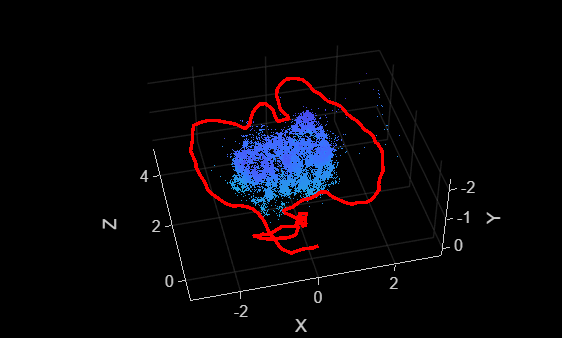rgbdvslam
Feature-based visual simultaneous localization and mapping (vSLAM) and visual-inertial sensor fusion with RGB-D camera
Since R2024a
Description
Use the rgbdvslam object to perform visual simultaneous
localization and mapping (vSLAM) with RGB-D camera data. RGB-D vSLAM combines depth
information from sensors, such as RGB-D cameras or depth sensors, with RGB images to
simultaneously estimate the camera pose and create a map of the environment. To learn more
about visual SLAM, see Implement Visual SLAM in MATLAB.
The rgbdvslam object extracts Oriented FAST and Rotated BRIEF (ORB)
features from incrementally read images, and then tracks those features to estimate camera
poses, identify key frames, and reconstruct a 3-D environment. The vSLAM algorithm also
searches for loop closures using the bag-of-features algorithm, and then optimizes the camera
poses using pose graph optimization. You can enhance the accuracy and robustness of the SLAM
by integrating this object with IMU data to perform visual-inertial sensor fusion.
Creation
Syntax
Description
vslam = rgbdvslam(intrinsics)vslam, by using the specified
camera intrinsic parameters.
The rgbdvslam object assumes the color and the depth images have
been preregistered with one-to-one correspondence.
The object represents 3-D map points and camera poses in world coordinates, and
assumes the camera pose of the first key frame is an identity rigidtform3d
transform.
Note
The rgbdvslam object runs on multiple threads internally, which can delay the processing of an image frame added by using the addFrame function. Additionally, the object running on multiple threads means the current frame the object is processing can be different than the recently added frame.
vslam = rgbdvslam(intrinsics,depthScaleFactor)1.
vslam = rgbdvslam(___,imuParameters)imuParameters. Using this argument
with IMU data, requires the Navigation Toolbox™.
vslam = rgbdvslam(intrinsics,PropertyName=Value)MaxNumPoints=850 sets the maximum number of ORB feature points to
extract from each image to 850.
Input Arguments
Properties
Object Functions
addFrame | Add pair of color and depth images to RGB-D visual SLAM object |
hasNewKeyFrame | Check if new key frame added in RGB-D visual SLAM object |
checkStatus | Check status of visual RGB-D SLAM object |
isDone | End-of-processing status for RGB-D visual SLAM object |
mapPoints | Build 3-D map of world points from RGB-D vSLAM object |
poses | Absolute camera poses of RGB-D vSLAM key frames |
plot | Plot 3-D map points and estimated camera trajectory in RGB-D visual SLAM |
reset | Reset RGB-D visual SLAM object |
Examples
References
[1] Mur-Artal, Raul, J. M. M. Montiel, and Juan D. Tardos. “ORB-SLAM: A Versatile and Accurate Monocular SLAM System.” IEEE Transactions on Robotics 31, no. 5 (October 2015): 1147–63. https://doi.org/10.1109/TRO.2015.2463671.
Extended Capabilities
Version History
Introduced in R2024aSee Also
Objects
monovslam|factorIMUParameters(Navigation Toolbox) |cameraIntrinsics|imageDatastore|ORBPoints


